All-inclusive Northern Lights trips in Tromsø, Norway. Small groups, big experiences! Highly qualified guides ensure unique and unforgettable adventures with a personal touch. Visit Explore the Arctic | | |
SIMMERING QUIET: Earth is passing through a disorganized stream of solar wind flowing from a network of small holes in the sun's atmosphere. So far the gentle buffeting has caused only minor geomagnetic unrest. "Simmering quiet" conditions should continue until July 1st or 2nd, when a more coherent stream is expected to arrive. Free: Aurora alerts.
MARTIAN GLITTER PATH: Mars is brightening as it approaches Earth for a 15-year close encounter on July 27th. The Red Planet now shines like a beacon in the midnight sky second in luminosity only to giant Jupiter. "With Mars now so bright, it casts a glitter path on the water as it rises in the southeast, reports Alan Dyer, who took this picture from a prairie pond near his home in Alberta, Canada:
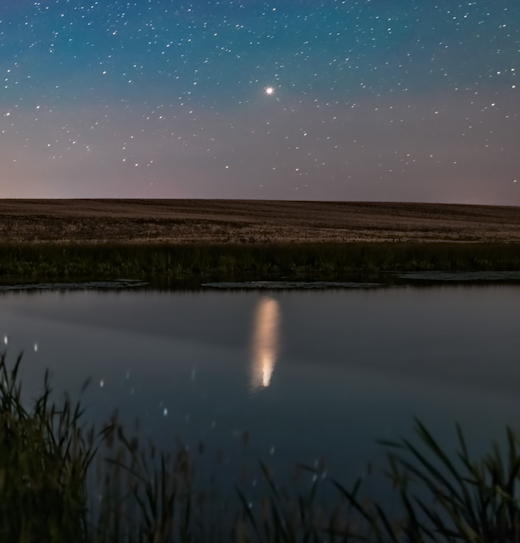
A glitter path is a band of light in the water. It is caused by reflections from the troughs and crest of tiny waves. Normally, only the sun and Moon (and sometimes Venus and Jupiter) produce glitter paths. Now Mars is doing it too.
"I also took a panoramic shot showing Mars and Jupiter with their respective glitter paths flanking the Milky Way and Saturn in Sagittarius," says Dyer.
The glitter is about to multiply. On June 29th and 30th, the waning gibbous Moon will pass Mars in the constellation Capricornus, producing a bright double glitter path for anyone standing on a beach at midnight. Enjoy the show! Sky maps: June 29, 30.
Realtime Space Weather Photo Gallery
NOCTILUCENT CLOUDS FROM ABOVE & BELOW: For the 4th week in a row, NASA's AIM spacecraft has observed an increase in noctilucent clouds (NLCs) above the Arctic Circle. This is the latest image showing our planet's north pole capped in electric-blue:
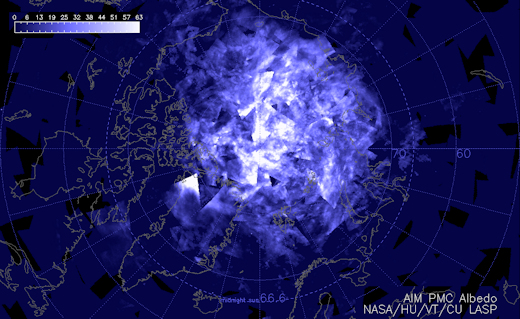
AIM is in a polar orbit ~500 km above Earth's surface--the perfect location to see noctilucent clouds. Data from the spacecraft show electric-blue tendrils spilling over the Arctic Circle into Canada and especially Europe.
As AIM monitors the clouds from above, people are starting to see them from below as well. Last night, Michael Zavyalov took this picture from Vyatskoe, a village in the Yaroslavl region of Russia:
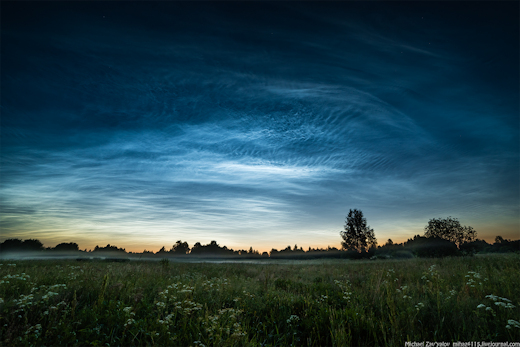
"The silvery clouds were uniquely vivid," says Zavyalov. "They glowed in the night sky long after sunset with waves and ripples unlike any other clouds I have seen."
NLCs are our planet's highest clouds. They form when summertime wisps of water vapor rise to the top of Earth's atmosphere and crystalize around specks of meteor smoke. Rippling mesospheric winds gather the resulting ice crystals into swarms floating ~80 km above the ground.
When noctilucent clouds first appeared in the 19th century, you had to travel to the Arctic to see them. In recent years, however, NLCs have intensified and spread with summer sightings as far south as Utah and Colorado. Observing tips: Look west 30 to 60 minutes after sunset when the sun has dipped well below the horizon. If you see luminous blue-white tendrils spreading across the sky, you may have spotted a noctilucent cloud.
Realtime Noctilucent Cloud Photo Gallery
ONE RING TO RULE THE STRATOSPHERE: This week, the students of Earth to Sky Calculus are in New Zealand launching cosmic ray balloons over Earth's 8th continent. To pay for the helium, they launched a ring of power to the stratosphere. Here it is floating 33 km above the Sierra Nevada mountains of central California:
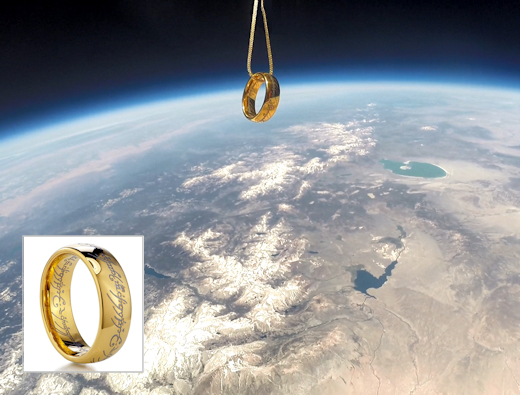
You can have one for $119.95. The students are selling these rings as a fundraiser for their trip. They are made of golden-colored tungsten and inscribed with the authentic Mordor script of the One Ring.
Buy one now, and we will fly it again for you over Hobbiton, located in the North Island of New Zealand where our cosmic ray balloons will be released. Just note "Please fly it again!" in the comments section at checkout.
Each golden ring comes with a greeting card showing the ring in flight and telling the story of its journey to the edge of space. Sales support the Earth to Sky Calculus cosmic ray ballooning program and hands-on STEM research.
Far Out Gifts: Earth to Sky Store
All proceeds support hands-on STEM education
Realtime Aurora Photo Gallery
Every night, a network of
NASA all-sky cameras scans the skies above the United States for meteoritic fireballs. Automated software maintained by NASA's Meteoroid Environment Office calculates their orbits, velocity, penetration depth in Earth's atmosphere and many other characteristics. Daily results are presented here on Spaceweather.com.
On Jun. 29, 2018, the network reported 8 fireballs.
(6 sporadics, 2 Northern June Aquilids)

In this diagram of the inner solar system, all of the fireball orbits intersect at a single point--Earth. The orbits are color-coded by velocity, from slow (red) to fast (blue). [Larger image] [movies]
Potentially Hazardous Asteroids (
PHAs) are space rocks larger than approximately 100m that can come closer to Earth than 0.05 AU. None of the known PHAs is on a collision course with our planet, although astronomers are finding
new ones all the time.
On June 29, 2018 there were 1912 potentially hazardous asteroids.
 |
Recent & Upcoming Earth-asteroid encounters: | Asteroid | Date(UT) | Miss Distance | Velocity (km/s) | Diameter (m) |
| 441987 | 2018-Jun-24 | 7.3 LD | 12.6 | 178 |
| 2018 LD3 | 2018-Jun-24 | 19.7 LD | 14.1 | 70 |
| 2018 MX4 | 2018-Jun-27 | 5.5 LD | 8 | 15 |
| 2018 LN2 | 2018-Jun-28 | 10.5 LD | 9.4 | 87 |
| 2018 MH7 | 2018-Jun-28 | 11.4 LD | 4.4 | 20 |
| 2018 LR3 | 2018-Jun-29 | 6 LD | 3.8 | 20 |
| 2018 LT6 | 2018-Jul-01 | 11.6 LD | 12.9 | 126 |
| 2018 LJ1 | 2018-Jul-01 | 13.9 LD | 2.7 | 18 |
| 2018 MB7 | 2018-Jul-04 | 2.8 LD | 11.6 | 64 |
| 2018 LQ2 | 2018-Aug-27 | 9.4 LD | 1.5 | 41 |
Notes: LD means "Lunar Distance." 1 LD = 384,401 km, the distance between Earth and the Moon. 1 LD also equals 0.00256 AU. MAG is the visual magnitude of the asteroid on the date of closest approach. | | Cosmic Rays in the Atmosphere |
Readers, thank you for your patience while we continue to develop this new section of Spaceweather.com. We've been working to streamline our data reduction, allowing us to post results from balloon flights much more rapidly, and we have developed a new data product, shown here:

This plot displays radiation measurements not only in the stratosphere, but also at aviation altitudes. Dose rates are expessed as multiples of sea level. For instance, we see that boarding a plane that flies at 25,000 feet exposes passengers to dose rates ~10x higher than sea level. At 40,000 feet, the multiplier is closer to 50x. These measurements are made by our usual cosmic ray payload as it passes through aviation altitudes en route to the stratosphere over California.
What is this all about? Approximately once a week, Spaceweather.com and the students of Earth to Sky Calculus fly space weather balloons to the stratosphere over California. These balloons are equipped with radiation sensors that detect cosmic rays, a surprisingly "down to Earth" form of space weather. Cosmic rays can seed clouds, trigger lightning, and penetrate commercial airplanes. Furthermore, there are studies ( #1, #2, #3, #4) linking cosmic rays with cardiac arrhythmias and sudden cardiac death in the general population. Our latest measurements show that cosmic rays are intensifying, with an increase of more than 13% since 2015:
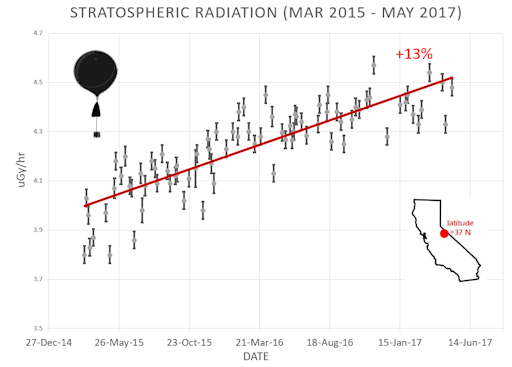
Why are cosmic rays intensifying? The main reason is the sun. Solar storm clouds such as coronal mass ejections (CMEs) sweep aside cosmic rays when they pass by Earth. During Solar Maximum, CMEs are abundant and cosmic rays are held at bay. Now, however, the solar cycle is swinging toward Solar Minimum, allowing cosmic rays to return. Another reason could be the weakening of Earth's magnetic field, which helps protect us from deep-space radiation.
The radiation sensors onboard our helium balloons detect X-rays and gamma-rays in the energy range 10 keV to 20 MeV. These energies span the range of medical X-ray machines and airport security scanners.
The data points in the graph above correspond to the peak of the Reneger-Pfotzer maximum, which lies about 67,000 feet above central California. When cosmic rays crash into Earth's atmosphere, they produce a spray of secondary particles that is most intense at the entrance to the stratosphere. Physicists Eric Reneger and Georg Pfotzer discovered the maximum using balloons in the 1930s and it is what we are measuring today.
| | The official U.S. government space weather bureau |
| | The first place to look for information about sundogs, pillars, rainbows and related phenomena. |
| | Researchers call it a "Hubble for the sun." SDO is the most advanced solar observatory ever. |
| | 3D views of the sun from NASA's Solar and Terrestrial Relations Observatory |
| | Realtime and archival images of the Sun from SOHO. |
| | from the NOAA Space Environment Center |
| | fun to read, but should be taken with a grain of salt! Forecasts looking ahead more than a few days are often wrong. |
| | from the NOAA Space Environment Center |
| | the underlying science of space weather |
 | Reviews here can help you to pick up best memory foam mattresses. |
| | These links help Spaceweather.com stay online. Thank you to our supporters! |
| | | | | | |

